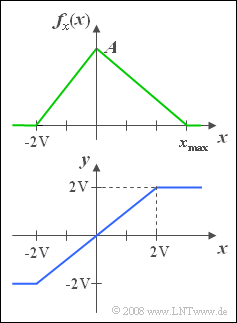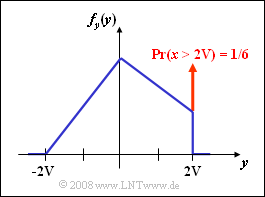Difference between revisions of "Aufgaben:Exercise 3.1Z: Triangular PDF"
| (7 intermediate revisions by 2 users not shown) | |||
| Line 1: | Line 1: | ||
| − | {{quiz-Header|Buchseite=Theory_of_Stochastic_Signals/ | + | {{quiz-Header|Buchseite=Theory_of_Stochastic_Signals/Probability_Density_Function |
}} | }} | ||
| − | [[File:P_ID109__Sto_Z_3_1.png|right|frame| | + | [[File:P_ID109__Sto_Z_3_1.png|right|frame|Triangular PDF and <br>characteristic curve $y(x)$]] |
| − | We consider a continuous random variable $x$ with the PDF outlined | + | We consider a continuous random variable $x$ with the PDF outlined on the right. |
*The minimum value of the signal is $x_{\rm min} = -2\hspace{0.05cm} {\rm V}$. | *The minimum value of the signal is $x_{\rm min} = -2\hspace{0.05cm} {\rm V}$. | ||
| − | *On the other hand, the maximum value $x_{\rm max}$ is a free parameter, allowing values between $+2\hspace{0.05cm}\rm V$ and $+4\hspace{0.05cm} \rm V$ | + | *On the other hand, the maximum value $x_{\rm max}$ is a free parameter, allowing values between $+2\hspace{0.05cm}\rm V$ and $+4\hspace{0.05cm} \rm V$. |
The random variable $x$ is to be understood here as the instantaneous value of a random signal. If this signal $x(t)$ is applied to an amplitude limiter with the characteristic curve (see sketch below) | The random variable $x$ is to be understood here as the instantaneous value of a random signal. If this signal $x(t)$ is applied to an amplitude limiter with the characteristic curve (see sketch below) | ||
| − | $$y(t)=\left\{\begin{array}{*{4}{c}} -2\hspace{0.05cm} {\rm V} & {\rm if}\hspace{0.1cm} x(t)<-2\hspace{0.05cm} {\rm V} , \\ x(t) & {\rm if}\hspace{0.1cm}-2\hspace{0.05cm} {\rm V} \le x(t)\le +2\hspace{0.05cm} {\rm V}, \\ +2\hspace{0.05cm} {\rm V} & {\rm if}\hspace{0.1cm} {\it x}({\it t})>+2\hspace{0.05cm} {\rm V}, \\\end{array}\right.$$ | + | :$$y(t)=\left\{\begin{array}{*{4}{c}} -2\hspace{0.05cm} {\rm V} & {\rm if}\hspace{0.1cm} x(t)<-2\hspace{0.05cm} {\rm V} , \\ x(t) & {\rm if}\hspace{0.1cm}-2\hspace{0.05cm} {\rm V} \le x(t)\le +2\hspace{0.05cm} {\rm V}, \\ +2\hspace{0.05cm} {\rm V} & {\rm if}\hspace{0.1cm} {\it x}({\it t})>+2\hspace{0.05cm} {\rm V}, \\\end{array}\right.$$ |
| − | so the signal $y(t)$ or the new random | + | so the signal $y(t)$ or the new random variable $y$, which is considered in the last two subquestions '''(5)''' and '''(6)''' is obtained. <br /> |
*For the subtasks '''(1)''' and '''(2)''' apply $x_{\rm max} = 2\hspace{0.05cm} {\rm V} $. | *For the subtasks '''(1)''' and '''(2)''' apply $x_{\rm max} = 2\hspace{0.05cm} {\rm V} $. | ||
| − | * For all other subtasks, set $x_{\rm max} = 4\hspace{0.05cm} {\rm V} $ . | + | * For all other subtasks, set $x_{\rm max} = 4\hspace{0.05cm} {\rm V} $ . |
| − | |||
| − | |||
| Line 24: | Line 22: | ||
Hints: | Hints: | ||
| − | *The task belongs to the chapter [[Theory_of_Stochastic_Signals/ | + | *The task belongs to the chapter [[Theory_of_Stochastic_Signals/Probability_Density_Function|Probability Density Function]]. |
| − | *The topic of this chapter is illustrated with examples in the (German) learning video [[Wahrscheinlichkeit_und_WDF_(Lernvideo)|Wahrscheinlichkeit und WDF]] $\Rightarrow$ Probability and PDF. | + | *The topic of this chapter is illustrated with examples in the (German language) learning video <br> [[Wahrscheinlichkeit_und_WDF_(Lernvideo)|"Wahrscheinlichkeit und WDF"]] $\Rightarrow$ "Probability and PDF". |
| Line 32: | Line 30: | ||
<quiz display=simple> | <quiz display=simple> | ||
| − | {Let $x_{\rm max} = +2\hspace{0.05cm} {\rm V}$. Calculate the parameter $A = f_x(0)$. | + | {Let be $x_{\rm max} = +2\hspace{0.05cm} {\rm V}$. Calculate the parameter $A = f_x(0)$. |
|type="{}"} | |type="{}"} | ||
$A \ = \ $ { 0.5 3% } $\ \rm 1/V$. | $A \ = \ $ { 0.5 3% } $\ \rm 1/V$. | ||
| − | { | + | {Let $x_{\rm max} = +2\hspace{0.05cm} {\rm V}$. What is the probability that $|x(t)|$ less than $x_{\rm max}/2$? |
|type="{}"} | |type="{}"} | ||
| − | ${\rm Pr}(|\hspace{0.05cm}x\hspace{0.05cm}| < | + | ${\rm Pr}(|\hspace{0.05cm}x\hspace{0.05cm}| < 1\hspace{0.05cm} {\rm V}) \ = \ $ { 0.75 3% } |
| − | {Now let $x_{\rm max} = +4\hspace{0.05cm} {\rm V}$. What is the probability that $x$ lies between $+1\hspace{0.05cm} {\rm V}$ and $+3\hspace{0.05cm} {\rm V}$ | + | {Now let be $x_{\rm max} = +4\hspace{0.05cm} {\rm V}$. What is the probability that $x$ lies between $+1\hspace{0.05cm} {\rm V}$ and $+3\hspace{0.05cm} {\rm V}$? |
|type="{}"} | |type="{}"} | ||
${\rm Pr}(1\hspace{0.05cm} {\rm V} < x <3\hspace{0.05cm} {\rm V}) \ = \ $ { 0.333 3% } | ${\rm Pr}(1\hspace{0.05cm} {\rm V} < x <3\hspace{0.05cm} {\rm V}) \ = \ $ { 0.333 3% } | ||
| − | { Let further $x_{\rm max} = +4\hspace{0.05cm} {\rm V}$. What is the probability that $x$ is exactly equal to $+2\hspace{0.05cm} {\rm V}$ | + | { Let further be $x_{\rm max} = +4\hspace{0.05cm} {\rm V}$. What is the probability that $x$ is exactly equal to $+2\hspace{0.05cm} {\rm V}$? |
|type="{}"} | |type="{}"} | ||
${\rm Pr}(x =2\hspace{0.05cm} {\rm V})\ = \ $ { 0. } | ${\rm Pr}(x =2\hspace{0.05cm} {\rm V})\ = \ $ { 0. } | ||
| − | { Let further $x_{\rm max} = +4\hspace{0.05cm} {\rm V}$. Which of the following statements is true? | + | { Let further be $x_{\rm max} = +4\hspace{0.05cm} {\rm V}$. Which of the following statements is true? |
|type="[]"} | |type="[]"} | ||
- $y$ is a continuous random variable. | - $y$ is a continuous random variable. | ||
| Line 59: | Line 57: | ||
| − | { | + | {Let further be $x_{\rm max} = +4\hspace{0.05cm} {\rm V}$. What is the probability that $y$ is exactly equal $+2\hspace{0.05cm} {\rm V}$? |
|type="{}"} | |type="{}"} | ||
${\rm Pr}(y =2\hspace{0.05cm} {\rm V})\ = \ $ { 0.167 3% } | ${\rm Pr}(y =2\hspace{0.05cm} {\rm V})\ = \ $ { 0.167 3% } | ||
| Line 70: | Line 68: | ||
===Solution=== | ===Solution=== | ||
{{ML-Kopf}} | {{ML-Kopf}} | ||
| − | [[File: | + | [[File:EN_Sto_Z_3_1_bc.png|right|frame|Height and area of triangular PDF]] |
| − | '''(1)''' The area under the PDF must always yield the value $1$ | + | '''(1)''' The area under the PDF must always yield the value $1$. It follows that: |
:$${A}/{ 2}\cdot {4\hspace{0.05cm}\rm V}=1\hspace{0.5cm}\Rightarrow\hspace{0.5cm} A | :$${A}/{ 2}\cdot {4\hspace{0.05cm}\rm V}=1\hspace{0.5cm}\Rightarrow\hspace{0.5cm} A | ||
\hspace{0.15cm}\underline{=\rm 0.5\;{1}/{V}}.$$ | \hspace{0.15cm}\underline{=\rm 0.5\;{1}/{V}}.$$ | ||
| Line 84: | Line 82: | ||
| − | '''(3)''' With $x_{\rm max} = +4\hspace{0.05cm} {\rm V}$ one obtains the PDF shown on the right. | + | '''(3)''' With $x_{\rm max} = +4\hspace{0.05cm} {\rm V}$ one obtains the PDF shown on the right. |
*The maximum value is now $A = 1/(3\hspace{0.05cm} {\rm V})$. | *The maximum value is now $A = 1/(3\hspace{0.05cm} {\rm V})$. | ||
| − | *The shaded area again indicates the probability we are looking for, which can be determined | + | *The shaded area again indicates the probability we are looking for, which can be determined using the rectangle of equal area: |
:$${\rm Pr}(1\hspace{0.05cm} {\rm V}< x<3\hspace{0.05cm} {\rm V})=\rm \frac{1}{6\hspace{0.05cm} {\rm V}}\cdot 2\hspace{0.05cm} {\rm V}=\hspace{0.15cm}\underline{0.333}.$$ | :$${\rm Pr}(1\hspace{0.05cm} {\rm V}< x<3\hspace{0.05cm} {\rm V})=\rm \frac{1}{6\hspace{0.05cm} {\rm V}}\cdot 2\hspace{0.05cm} {\rm V}=\hspace{0.15cm}\underline{0.333}.$$ | ||
| − | '''(4)''' Since $x$ represents a continuous random variable, this probability is by definition zero ⇒ ${\rm Pr}(x =2\hspace{0.05cm} {\rm V}) \;\underline {= 0}$. | + | '''(4)''' Since $x$ represents a continuous random variable, this probability is by definition zero ⇒ ${\rm Pr}(x =2\hspace{0.05cm} {\rm V}) \;\underline {= 0}$. |
| Line 99: | Line 97: | ||
*The PDF $f_y(y)$ includes a continuous component (drawn in blue), | *The PDF $f_y(y)$ includes a continuous component (drawn in blue), | ||
| − | *but also the (red) Dirac function at $y = +2\hspace{0.05cm} {\rm V}$ with weight ${\rm Pr}(x >2\hspace{0.05cm} {\rm V})$. | + | *but also the (red) Dirac delta function at $y = +2\hspace{0.05cm} {\rm V}$ with weight ${\rm Pr}(x >2\hspace{0.05cm} {\rm V})$. |
| + | |||
| − | '''(6)''' | + | '''(6)''' The graphic on the right shows the probability density function of the random variable $y$. |
| − | *From the right figure for | + | *From the right figure for subtask '''(3)''' one can see the relation: |
:$${\rm Pr}( y=2\hspace{0.05cm} {\rm V}) = {\rm Pr}( x> 2\hspace{0.05cm} {\rm V}) = \frac{1}{2}\cdot\frac{1}{6\hspace{0.05cm} {\rm V}}\cdot2{\hspace{0.05cm} {\rm V}} = {1}/{6}\hspace{0.15cm}\underline{=0.167}.$$ | :$${\rm Pr}( y=2\hspace{0.05cm} {\rm V}) = {\rm Pr}( x> 2\hspace{0.05cm} {\rm V}) = \frac{1}{2}\cdot\frac{1}{6\hspace{0.05cm} {\rm V}}\cdot2{\hspace{0.05cm} {\rm V}} = {1}/{6}\hspace{0.15cm}\underline{=0.167}.$$ | ||
{{ML-Fuß}} | {{ML-Fuß}} | ||
Latest revision as of 17:55, 8 February 2022
We consider a continuous random variable $x$ with the PDF outlined on the right.
- The minimum value of the signal is $x_{\rm min} = -2\hspace{0.05cm} {\rm V}$.
- On the other hand, the maximum value $x_{\rm max}$ is a free parameter, allowing values between $+2\hspace{0.05cm}\rm V$ and $+4\hspace{0.05cm} \rm V$.
The random variable $x$ is to be understood here as the instantaneous value of a random signal. If this signal $x(t)$ is applied to an amplitude limiter with the characteristic curve (see sketch below)
- $$y(t)=\left\{\begin{array}{*{4}{c}} -2\hspace{0.05cm} {\rm V} & {\rm if}\hspace{0.1cm} x(t)<-2\hspace{0.05cm} {\rm V} , \\ x(t) & {\rm if}\hspace{0.1cm}-2\hspace{0.05cm} {\rm V} \le x(t)\le +2\hspace{0.05cm} {\rm V}, \\ +2\hspace{0.05cm} {\rm V} & {\rm if}\hspace{0.1cm} {\it x}({\it t})>+2\hspace{0.05cm} {\rm V}, \\\end{array}\right.$$
so the signal $y(t)$ or the new random variable $y$, which is considered in the last two subquestions (5) and (6) is obtained.
- For the subtasks (1) and (2) apply $x_{\rm max} = 2\hspace{0.05cm} {\rm V} $.
- For all other subtasks, set $x_{\rm max} = 4\hspace{0.05cm} {\rm V} $ .
Hints:
- The task belongs to the chapter Probability Density Function.
- The topic of this chapter is illustrated with examples in the (German language) learning video
"Wahrscheinlichkeit und WDF" $\Rightarrow$ "Probability and PDF".
Questions
Solution
(1) The area under the PDF must always yield the value $1$. It follows that:
- $${A}/{ 2}\cdot {4\hspace{0.05cm}\rm V}=1\hspace{0.5cm}\Rightarrow\hspace{0.5cm} A \hspace{0.15cm}\underline{=\rm 0.5\;{1}/{V}}.$$
(2) With $x_{\rm max} = +2\hspace{0.05cm} {\rm V}$ the PDF is obtained according to the left graph.
- The shading marks the probability we are looking for.
- One obtains by simple geometric considerations:
- $${\rm Pr}(|x|<\rm 1\hspace{0.05cm} V)\hspace{0.15cm}\underline{=\rm 0.75}.$$
(3) With $x_{\rm max} = +4\hspace{0.05cm} {\rm V}$ one obtains the PDF shown on the right.
- The maximum value is now $A = 1/(3\hspace{0.05cm} {\rm V})$.
- The shaded area again indicates the probability we are looking for, which can be determined using the rectangle of equal area:
- $${\rm Pr}(1\hspace{0.05cm} {\rm V}< x<3\hspace{0.05cm} {\rm V})=\rm \frac{1}{6\hspace{0.05cm} {\rm V}}\cdot 2\hspace{0.05cm} {\rm V}=\hspace{0.15cm}\underline{0.333}.$$
(4) Since $x$ represents a continuous random variable, this probability is by definition zero ⇒ ${\rm Pr}(x =2\hspace{0.05cm} {\rm V}) \;\underline {= 0}$.
(5) Only the last statement of the given answers is true:
- The PDF $f_y(y)$ includes a continuous component (drawn in blue),
- but also the (red) Dirac delta function at $y = +2\hspace{0.05cm} {\rm V}$ with weight ${\rm Pr}(x >2\hspace{0.05cm} {\rm V})$.
(6) The graphic on the right shows the probability density function of the random variable $y$.
- From the right figure for subtask (3) one can see the relation:
- $${\rm Pr}( y=2\hspace{0.05cm} {\rm V}) = {\rm Pr}( x> 2\hspace{0.05cm} {\rm V}) = \frac{1}{2}\cdot\frac{1}{6\hspace{0.05cm} {\rm V}}\cdot2{\hspace{0.05cm} {\rm V}} = {1}/{6}\hspace{0.15cm}\underline{=0.167}.$$


